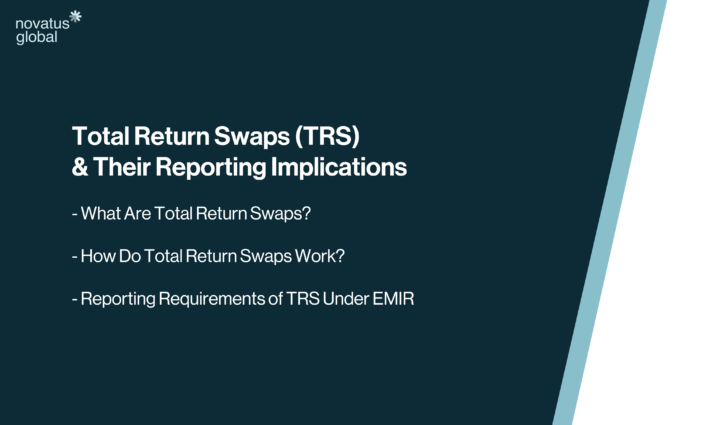
What are Total Return Swaps?
A Total Return Swap (TRS) is a derivative contract where one party agrees to pay a fixed or variable rate, while the other party makes payments based on the total return of the underlying asset. The underlying asset is typically an equity index, bond or loan portfolio, allowing investors to gain exposure to the asset without owning it.
TRS are essential risk management tools for financial institutions, allowing them to manage exposure to the appreciation or depreciation of assets. They enable one party to receive the full economic return from price appreciation or income, while the counterparty receives a fixed or floating payment. This makes TRS useful for:
- Hedging against market fluctuations
- By entering into a TRS, parties can protect themselves against adverse price movements in the underlying asset
- Enhancing leverage with capital expenditure
- TRS enable investors to gain exposure to the asset without the need for upfront capital investment to buy the asset
- Optimising balance sheets by reducing capital requirements
- Financial institutions can use TRS to manage asset exposure efficiently, potentially lowering the capital reserves required under regulatory frameworks.

How do Total Return Swaps Work?
In a TRS, the “total return payer” transfers the economic performance of the underlying asset, including income and capital gains or losses, to the “total return receiver” for a fixed or variable (floating) payment. This differs from other similar instruments in the following ways:
-
-
- TRS vs Repo
- In a repo agreement, the ownership of the asset temporarily transfers, but in a TRS there is no ownership transfer
- TRS vs CDS (Credit Default Swap)
- CDS are based on the potential default of debt instruments and therefore protect against credit risk
- TRS gives the benefits of asset ownership, without actually owning the asset, by passing along gains and losses
- TRS vs Repo
-
Reporting Requirements for TRS under EMIR
Under the European Market Infrastructure Regulation (EMIR), TRS are subject to specific reporting obligations. They are classified as derivative contracts relying on the underlying asset being either an equity instrument or a debt instrument, as per the guidance from the European Securities and Markets Authority (ESMA).
Equity Derivatives: If the underlying asset is an equity or equity index, the TRS should be reported as an equity derivative.
Credit Derivatives: If the underlying asset is a bond or loan, the TRS should be reported as a credit derivative.
What Should be Reported
When reporting TRS under EMIR, counterparties must report key details such as:
-
-
- Counterparty Information
- Identification of both parties involved in the TRS, specifying whether they are financial or non-financial counterparties
- Notional Amount and Currency
- The face value of the TRS and the currency in which the transaction was conducted
- Transaction Details
- Including contract date, agreed-upon expiration date (maturity) and lifecycle details
- Counterparty Information
-
Special Considerations
There are some factors to consider carefully when reporting TRS under EMIR:
-
-
- Lifecycle Event Reporting: any events that affect the terms or valuation of the TRS must be reported to maintain up-to-date records
- Index-Based TRS: for TRS based on indices, the specific index must be identified and reporting must reflect the aggregated nature of the underlying assets
- Specific Fields: reporting must accurately specify fields for the Fixed Rate of Leg 1 and Leg 2, and Spread of Leg 1 and Leg 2.
-
Key Challenges and Regulatory Considerations for TRS Reporting
Reporting TRS under EMIR presents several challenges, particularly in pricing and valuation complexity. TRS valuations fluctuate based on the performance of the underlying assets, so firms must ensure accurate assessments throughout the lifecycle of the trade. Another key consideration is data consistency, as discrepancies between counterparties could lead to inaccurate information being reported.
TRS can often be subject to multiple regulatory frameworks which could cause issues with cross-regulatory compliance. This includes the Securities Financing Transactions Regulation (SFTR) and firms should be aware of any potential overlapping obligations.
Firms must stay up to date with evolving regulatory scrutiny and ensuring accuracy in trade reporting is essential to remain compliant and avoid costly penalties.











